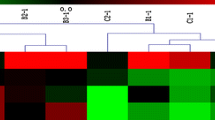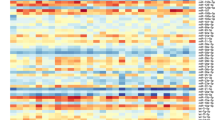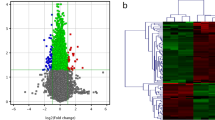Abstract
The objective of this study was to identify different transcriptome expression profiles involved in the pathogenesis of diabetic nephropathy (DN) and to illustrate the diagnostic and therapeutic potential of mRNAs, long noncoding RNAs (lncRNAs), and circular RNAs (circRNAs) in DN progression. The participants were divided into four groups: normoalbuminuria (group DM), microalbuminuria (group A2), macroalbuminuria (group A3) and healthy controls (group N). There were three individuals in each group for sequencing. Transcriptome sequencing analysis was performed on the peripheral blood of all the participants to identify the differential expression of mRNAs, lncRNAs, and circRNAs between intervention groups and controls. The functional enrichment analysis, the short time-series expression miner (STEM) program, and the miRNA–circRNA–mRNA network were further conducted. To verify the reproducibility of transcriptome sequencing, 10 and 30 blood samples were collected from the control and diseased groups, respectively. Four candidate biomarkers were selected from differentially expressed circRNAs (circ_0005379, circ_0002024, and circ_0000567, and circ_0001017) and their concentrations in the blood were measured using quantitative PCR (qPCR). In the comparison of A2 with N, 549 mRNAs, 1259 lncRNAs, and 12 circRNAs were screened. In the comparison of A3 with N, 1217 mRNAs, 1613 lncRNAs, and 24 circRNAs were screened. Moreover, in the comparison of diabetes mellitus (DM) with N, 948 mRNAs, 1495 lncRNAs, and 25 circRNAs were screened. Functional enrichment analysis showed that differentially expressed mRNAs were related to insulin secretion, insulin resistance, and inflammation, while differentially expressed lncRNAs were mainly associated with crossover junction endodeoxyribonuclease activity. In STEM analysis, a total of 481 mRNAs and 152 differential expression circRNAs showed a significant tendency. The key relationships in the miRNA–circRNA–mRNA network were identified, such as hsa-miR-103a-3p-circ_0005379-PTEN, hsa-miR-497-5p-circ_0002024-IGF1R and hsa-miR-1269a-circ_0000567-SOX6. In addition, qPCR showed consistent results with RNA sequencing. We found that differentially expressed mRNAs, lncRNAs, and circRNAs participated in DN development. Circ_0005379, circ_0002024, and circ_0000567 could be adopted as potential biomarkers for DN.










Similar content being viewed by others
Data availability
Data will be available on reasonable request.
References
Quinn JJ, Chang HY (2016) Unique features of long non-coding RNA biogenesis and function. Nat Rev Genet 17:47–62. https://doi.org/10.1038/nrg.2015.10
Kung JT, Colognori D, Lee JT (2013) Long noncoding RNAs: past, present, and future. Genetics 193:651–669. https://doi.org/10.1534/genetics.112.146704
Flynn RA, Chang HY (2014) Long noncoding RNAs in cell-fate programming and reprogramming. Cell Stem Cell 14:752–761. https://doi.org/10.1016/j.stem.2014.05.014
Memczak S, Jens M, Elefsinioti A, Torti F, Krueger J, Rybak A, Maier L, Mackowiak SD, Gregersen LH, Munschauer M et al (2013) Circular RNAs are a large class of animal RNAs with regulatory potency. Nature 495:333–338. https://doi.org/10.1038/nature11928
Harries LW (2012) Long non-coding RNAs and human disease. Biochem Soc Trans 40:902–906. https://doi.org/10.1042/bst20120020
Dechamethakun S, Muramatsu M (2017) Long noncoding RNA variations in cardiometabolic diseases. J Hum Genet 62:97–104. https://doi.org/10.1038/jhg.2016.70
Anders HJ, Huber TB, Isermann B, Schiffer M (2018) CKD in diabetes: diabetic kidney disease versus nondiabetic kidney disease. Nat Rev Nephrol 14:361–377. https://doi.org/10.1038/s41581-018-0001-y
Alicic RZ, Rooney MT, Tuttle KR (2017) Diabetic kidney disease: challenges, progress, and possibilities. Clin J Am Soc Nephrol 12:2032–2045. https://doi.org/10.2215/cjn.11491116
McKnight AJ, Patterson CC, Pettigrew KA, Savage DA, Kilner J, Murphy M, Sadlier D, Maxwell AP (2010) A GREM1 gene variant associates with diabetic nephropathy. J Am Soc Nephrol 21:773–781. https://doi.org/10.1681/asn.2009070773
McMahon R, Murphy M, Clarkson M, Taal M, Mackenzie HS, Godson C, Martin F, Brady HR (2000) IHG-2, a mesangial cell gene induced by high glucose, is human gremlin. Regulation by extracellular glucose concentration, cyclic mechanical strain, and transforming growth factor-beta1. J Biol Chem 275:9901–9904. https://doi.org/10.1074/jbc.275.14.9901
Walsh DW, Roxburgh SA, McGettigan P, Berthier CC, Higgins DG, Kretzler M, Cohen CD, Mezzano S, Brazil DP, Martin F (2008) Co-regulation of Gremlin and Notch signalling in diabetic nephropathy. Biochim Biophys Acta 1782:10–21. https://doi.org/10.1016/j.bbadis.2007.09.005
Rask-Madsen C, King GL (2008) Differential regulation of VEGF signaling by PKC-alpha and PKC-epsilon in endothelial cells. Arterioscler Thromb Vasc Biol 28:919–924. https://doi.org/10.1161/atvbaha.108.162842
Tufro A, Veron D (2012) VEGF and podocytes in diabetic nephropathy. Semin Nephrol 32:385–393. https://doi.org/10.1016/j.semnephrol.2012.06.010
Rossing K, Christensen PK, Hovind P, Parving HH (2005) Remission of nephrotic-range albuminuria reduces risk of end-stage renal disease and improves survival in type 2 diabetic patients. Diabetologia 48:2241–2247. https://doi.org/10.1007/s00125-005-1937-6
Chang AS, Hathaway CK, Smithies O, Kakoki M (2016) Transforming growth factor-β1 and diabetic nephropathy. Am J Physiol Ren Physiol 310:F689–F696. https://doi.org/10.1152/ajprenal.00502.2015
Vallon V, Rose M, Gerasimova M, Satriano J, Platt KA, Koepsell H, Cunard R, Sharma K, Thomson SC, Rieg T (2013) Knockout of Na-glucose transporter SGLT2 attenuates hyperglycemia and glomerular hyperfiltration but not kidney growth or injury in diabetes mellitus. Am J Physiol Ren Physiol 304:F156–F167. https://doi.org/10.1152/ajprenal.00409.2012
Araki S, Koya D, Makiishi T, Sugimoto T, Isono M, Kikkawa R, Kashiwagi A, Haneda M (2003) APOE polymorphism and the progression of diabetic nephropathy in Japanese subjects with type 2 diabetes: results of a prospective observational follow-up study. Diabetes Care 26:2416–2420. https://doi.org/10.2337/diacare.26.8.2416
Kalina A, Szalai C, Prohaszka Z, Reiber I, Csaszar A (2002) Association of plasma lipid levels with apolipoprotein E polymorphism in Type 2 diabetes. Diabetes Res Clin Pract 56:63–68. https://doi.org/10.1016/s0168-8227(01)00350-3
Harpaz E, Tamir S, Weinstein A, Weinstein Y (2017) The effect of caffeine on energy balance. J Basic Clin Physiol Pharmacol 28:1–10. https://doi.org/10.1515/jbcpp-2016-0090
Uchida S, Dimmeler S (2015) Long noncoding RNAs in cardiovascular diseases. Circ Res 116:737–750. https://doi.org/10.1161/circresaha.116.302521
Briggs JA, Wolvetang EJ, Mattick JS, Rinn JL, Barry G (2015) Mechanisms of long non-coding RNAs in mammalian nervous system development, plasticity, disease, and evolution. Neuron 88:861–877. https://doi.org/10.1016/j.neuron.2015.09.045
Yi H, Peng R, Zhang LY, Sun Y, Peng HM, Liu HD, Yu LJ, Li AL, Zhang YJ, Jiang WH et al (2017) lncRNA-Gm4419 knockdown ameliorates NF-κB/NLRP3 inflammasome-mediated inflammation in diabetic nephropathy. Cell Death Dis 8:e2583. https://doi.org/10.1038/cddis.2016.451
Chen K, Yu B, Liao J (2021) lncRNA SOX2OT alleviates mesangial cell proliferation and fibrosis in diabetic nephropathy via Akt/mTOR-mediated autophagy. Mol Med 27:71. https://doi.org/10.1186/s10020-021-00310-6
Zhang H, Yan Y, Hu Q, Zhang X (2021) lncRNA MALAT1/microRNA let-7f/KLF5 axis regulates podocyte injury in diabetic nephropathy. Life Sci 266:118794. https://doi.org/10.1016/j.lfs.2020.118794
Hu W, Han Q, Zhao L, Wang L (2019) Circular RNA circRNA_15698 aggravates the extracellular matrix of diabetic nephropathy mesangial cells via miR-185/TGF-β1. J Cell Physiol 234:1469–1476. https://doi.org/10.1002/jcp.26959
Peng F, Gong W, Li S, Yin B, Zhao C, Liu W, Chen X, Luo C, Huang Q, Chen T et al (2020) circRNA_010383 acts as a sponge for miR-135a and its downregulated expression contributes to renal fibrosis in diabetic nephropathy. Diabetes. https://doi.org/10.2337/db200203
Lin J, Shi Y, Peng H, Shen X, Thomas S, Wang Y, Truong LD, Dryer SE, Hu Z, Xu J (2015) Loss of PTEN promotes podocyte cytoskeletal rearrangement, aggravating diabetic nephropathy. J Pathol 236:30–40. https://doi.org/10.1002/path.4508
Lu Q, Ma Z, Ding Y, Bedarida T, Chen L, Xie Z, Song P, Zou MH (2019) Circulating miR-103a-3p contributes to angiotensin II-induced renal inflammation and fibrosis via a SNRK/NF-κB/p65 regulatory axis. Nat Commun 10:2145. https://doi.org/10.1038/s41467-019-10116-0
Peters LJF, Floege J, Biessen EAL, Jankowski J, van der Vorst EPC (2020) MicroRNAs in chronic kidney disease: four candidates for clinical application. Int J Mol Sci 21:6547. https://doi.org/10.3390/ijms21186547
Jiang ZH, Tang YZ, Song HN, Yang M, Li B, Ni CL (2020) miRNA-342 suppresses renal interstitial fibrosis in diabetic nephropathy by targeting SOX6. Int J Mol Med 45:45–52. https://doi.org/10.3892/ijmm.2019.4388
Han Y, Xu H, Cheng J, Zhang Y, Gao C, Fan T, Peng B, Li B, Liu L, Cheng Z (2016) Downregulation of long non-coding RNA H19 promotes P19CL6 cells proliferation and inhibits apoptosis during late-stage cardiac differentiation via miR-19b-modulated Sox6. Cell Biosci 6:58. https://doi.org/10.1186/s13578-016-0123-5
Jin J, Sun H, Shi C, Yang H, Wu Y, Li W, Dong YH, Cai L, Meng XM (2020) Circular RNA in renal diseases. J Cell Mol Med 24:6523–6533. https://doi.org/10.1111/jcmm.15295
Tang B, Li W, Ji TT, Li XY, Qu X, Feng L, Bai S (2020) Circ-AKT3 inhibits the accumulation of extracellular matrix of mesangial cells in diabetic nephropathy via modulating miR-296-3p/E-cadherin signals. J Cell Mol Med 24:8779–8788. https://doi.org/10.1111/jcmm.15513
Iguchi H, Urashima Y, Inagaki Y, Ikeda Y, Okamura M, Tanaka T, Uchida A, Yamamoto TT, Kodama T, Sakai J (2007) SOX6 suppresses cyclin D1 promoter activity by interacting with beta-catenin and histone deacetylase 1, and its down-regulation induces pancreatic beta-cell proliferation. J Biol Chem 282:19052–19061. https://doi.org/10.1074/jbc.M700460200
Lv J, Wu Y, Mai Y, Bu S (2020) Noncoding RNAs in diabetic nephropathy: pathogenesis, biomarkers, and therapy. J Diabetes Res 2020:3960857. https://doi.org/10.1155/2020/3960857
Funding
The authors have not disclosed any funding.
Author information
Authors and Affiliations
Corresponding authors
Ethics declarations
Conflict of interest
The authors state that there are no conflicts of interest to disclose.
Additional information
Publisher's Note
Springer Nature remains neutral with regard to jurisdictional claims in published maps and institutional affiliations.
Rights and permissions
About this article
Cite this article
Jing, J., Song, L., Zuo, D. et al. Transcriptome expression profiles associated with diabetic nephropathy development. Mol Cell Biochem 477, 1931–1946 (2022). https://doi.org/10.1007/s11010-022-04420-5
Received:
Accepted:
Published:
Issue Date:
DOI: https://doi.org/10.1007/s11010-022-04420-5




